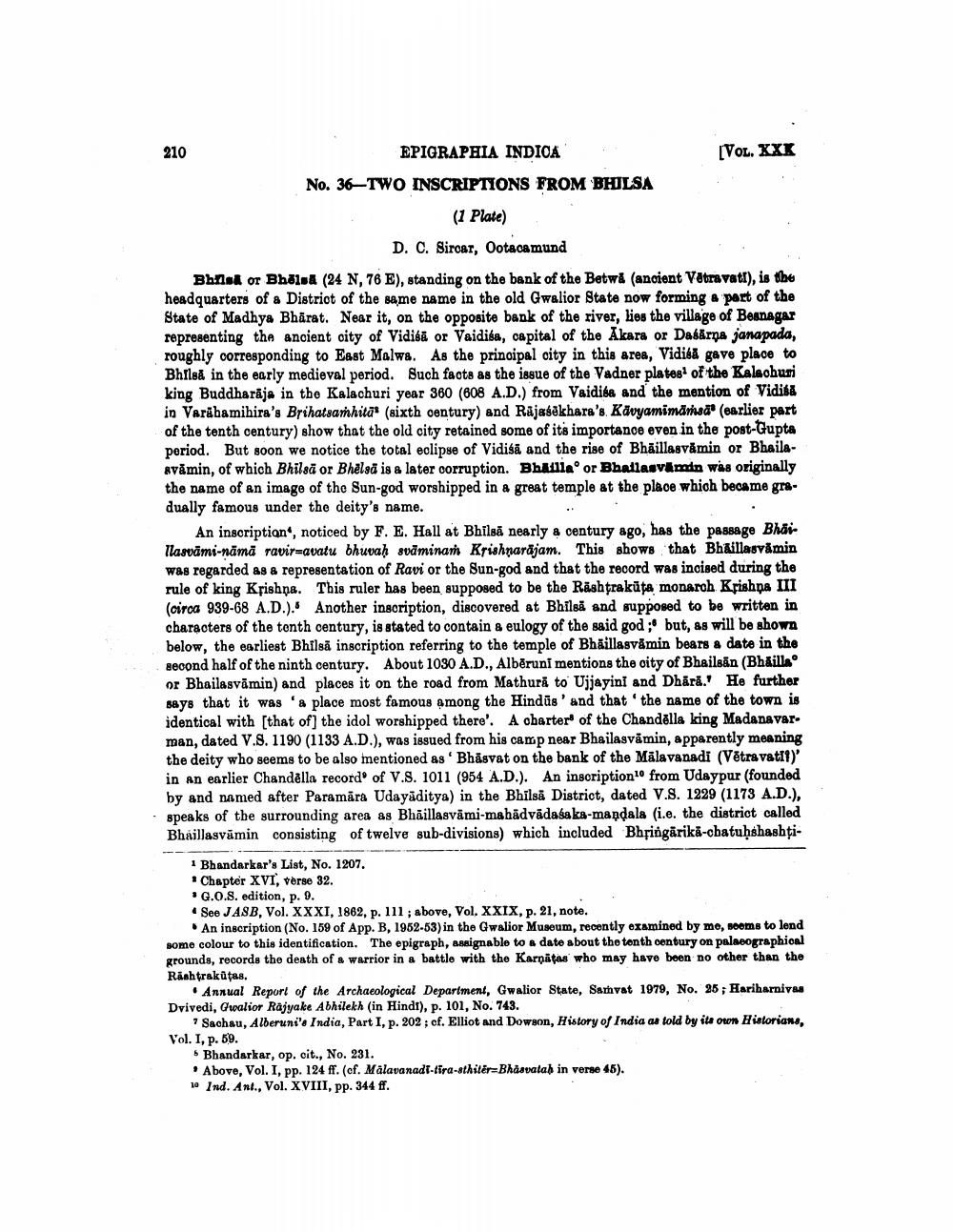________________
[VOL. XXK
210
EPIGRAPHIA INDICA No. 36-TWO INSCRIPTIONS FROM BHILSA
(1 Plate)
D. C. Sircar, Ootacamund Bhned or Bholoa (24 N, 76 E), standing on the bank of the Betwă (ancient Vetravatt), is the headquarters of a District of the same name in the old Gwalior State now forming a part of the State of Madhya Bharat. Near it, on the opposite bank of the river, lies the village of Bennagar representing the ancient city of Vidišā or Vaidisa, capital of the Akara or Dasárna janapada, roughly corresponding to East Malwa. As the principal city in this area, Vidida gave place to Bhilsă in the early medieval period. Such facts as the issue of the Vadner platest of the Kalachuri king Buddharāja in tbo Kalachuri year 360 (608 A.D.) from Vaidisa and the mention of Vidita in Varahamihira's Brihatsamhita* (sixth century) and Rajasekhara's Kavyamimärhed (earlier part of the tenth century) show that the old city retained some of its importance even in the post-Gupta period. But soon we notice the total eclipse of Vidišā and the rise of Bhäillasvämin or Bhailaavāmin, of which Bhilsā or Bhelst is a later corruption. Bhalla or Bhallasvamin was originally the name of an image of the Sun-god worshipped in a great temple at the place which became gredually famous under the deity's name.
An inscription", noticed by F. E. Hall at Bhilsā nearly a century ago, has the passage Bhaillasvämi-nāmā ravir=avatu bhuvah sväminar Krishnarajam. This shows that Bhaillauvāmin Was regarded as a representation of Ravi or the Sun-god and that the record was incised during the rule of king Krishna. This ruler has been supposed to be the Rashtrakūta monarch Krishna III (circa 939-68 A.D.). Another inscription, discovered at Bhilsã and supposed to be written in characters of the tenth century, is stated to contain & eulogy of the said god ;' but, as will be shown below, the earliest Bhilsă inscription referring to the temple of Bhăillasvåmin bears a date in the second half of the ninth century. About 1030 A.D., Albērunt mentions the city of Bhailsän (Bhailla or Bhailasvămin) and places it on the road from Mathurā to Ujjayini and Dhära. He further says that it was a place most famous among the Hindüs' and that 'the name of the town is identical with that of the idol worshipped there'. A charter of the Chandělla king Madanavar. man, dated V.8. 1190 (1133 A.D.), was issued from his camp near Bhailasvămin, apparently meaning the deity who seems to be also mentioned as 'Bhasvat on the bank of the Mālavanadi (Vētravati?)' in an earlier Chandella record of V.S. 1011 (954 A.D.). An inscription from Udaypur (founded by and named after Paramära Udayāditya) in the Bhilsa District, dated V.S. 1229 (1173 A.D.), speaks of the surrounding area as Bhāillasvämi-mahädvādasaka-mandala (i.e. the district called Bhaillasvāmin consisting of twelve sub-divisions) which included Bhțingārikā-chatuhshashti
1 Bhandarkar's List, No. 1207. * Chapter XVI, Verse 32. .G.O.S. edition, p. 9. • See JASB, Vol. XXXI, 1862, p. 111; above, Vol. XXIX, p. 21, note.
. An inscription (No. 159 of App. B, 1962-63) in the Gwalior Museum, recently examined by me, sooms to lend Bomo colour to this identification. The epigraph, assignable to a date about the tonth century on palaeographical grounds, records the death of a warrior in a battle with the Karnatas who may have been no other than the Rashtrakūtas.
• Annual Report of the Archaeological Department, Gwalior State, Samvat 1979, No. 26; Hariharnivas Dvivedi, Gwalior Rajyake Abhilekh (in Hindt), p. 101, No. 743.
* Sachau, Alberuni's India, Part I, p. 202 ; cf. Elliot and Dowson, History of India as told by its oton Historians, Vol. I, p. 59.
Bhandarkar, op. cit., No. 231. • Above, Vol. I, pp. 124 ff. (of. Mälavanadi-tira-sthiteraBhaavatah in verse 46). 10 Ind. Ant., Vol. XVIII, pp. 344 ff.




